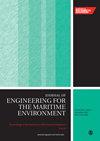Reanalysis of the revised EEDI parameters for inland ships of Bangladesh
IF 1.5
4区 工程技术
Q3 ENGINEERING, MARINE
Proceedings of the Institution of Mechanical Engineers, Part M: Journal of Engineering for the Maritime Environment
Pub Date : 2022-11-04
DOI:10.1177/14750902221131418
引用次数: 0
Abstract
A revision of the Energy Efficiency Design Index (EEDI) formulation was previously proposed to be useful for inland ships of Bangladesh. The study incorporated the shallow water effect using Schlichting’s method which has been developed in 1934 based on a large number of ship model tests to show how a ship’s resistance in shallow water deviates from that in deep water. However, the evaluation and presentation of Schlichting’s results did not cover all range of ship parameters. This reanalysis has considered the shallow water effect by actual measurement of 15 inland ships of Bangladesh. Later, the results of Schlichting’s method were compared with (a) actual investigation, (b) an improved version of Schlichting’s method proposed by Lackenby in 1963, and (c) a new method proposed by C B Barrass in 2004. It was found that the deviations of Schlichting’s results are much higher than Lackenby and Barrass’s methods in comparison to the investigated results. In a previous analysis of the inland ships of Bangladesh, the Maximum Continuous Rating (MCR) of the main engine was considered by using the Holtrop-Mennen method. As this method requires too much ship data, that analysis had assumed some unknown required ship data. This reanalysis has overcome that problem by the physical investigations of the same 15 inland ships of Bangladesh. The average MCR for inland cargo ships and oil tankers of Bangladesh are measured as 70% by the investigations, whereas it is 80% for passenger ships.孟加拉国内河船舶修订EEDI参数的再分析
以前曾建议修订能源效率设计指数(EEDI)公式,以便对孟加拉国的内河船舶有用。该研究采用了1934年在大量船舶模型试验的基础上发展起来的Schlichting方法,将浅水效应纳入其中,以显示船舶在浅水中的阻力与深水中的阻力如何偏离。然而,对Schlichting结果的评价和呈现并没有涵盖船舶参数的所有范围。本文通过对孟加拉国15艘内河船舶的实际测量,考虑了浅水效应。随后,将Schlichting方法的结果与(a)实际调查结果,(b) 1963年Lackenby提出的Schlichting方法的改进版本,以及(c) 2004年c b Barrass提出的新方法进行比较。结果发现,与所调查的结果相比,Schlichting方法的结果偏差远高于Lackenby和Barrass方法。在之前对孟加拉国内河船舶的分析中,采用Holtrop-Mennen方法考虑了主机的最大连续额定功率(MCR)。由于该方法需要大量的船舶数据,该分析假设了一些未知的所需船舶数据。这次重新分析通过对孟加拉国同样的15艘内河船进行实地调查,克服了这个问题。调查显示,孟加拉国内河货船和油轮的平均MCR为70%,而客船的平均MCR为80%。
本文章由计算机程序翻译,如有差异,请以英文原文为准。
求助全文
约1分钟内获得全文
求助全文
来源期刊

CiteScore
3.90
自引率
11.10%
发文量
77
审稿时长
>12 weeks
期刊介绍:
The Journal of Engineering for the Maritime Environment is concerned with the design, production and operation of engineering artefacts for the maritime environment. The journal straddles the traditional boundaries of naval architecture, marine engineering, offshore/ocean engineering, coastal engineering and port engineering.
 求助内容:
求助内容: 应助结果提醒方式:
应助结果提醒方式:


